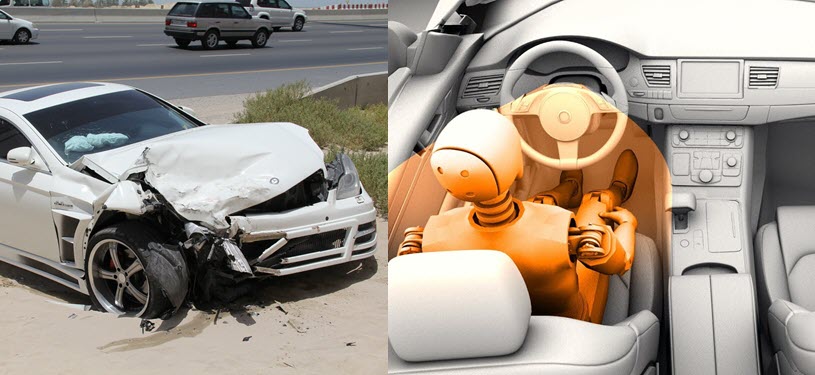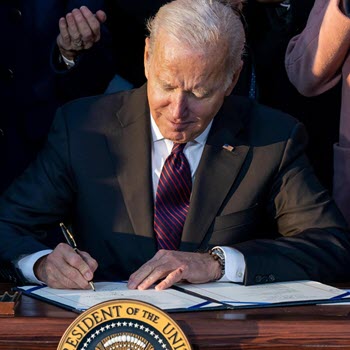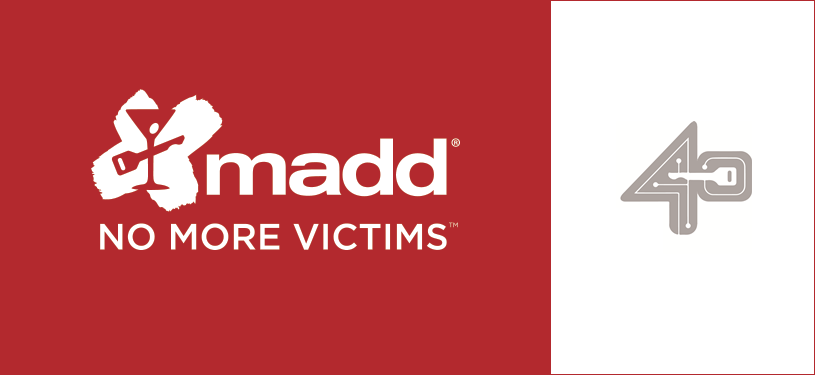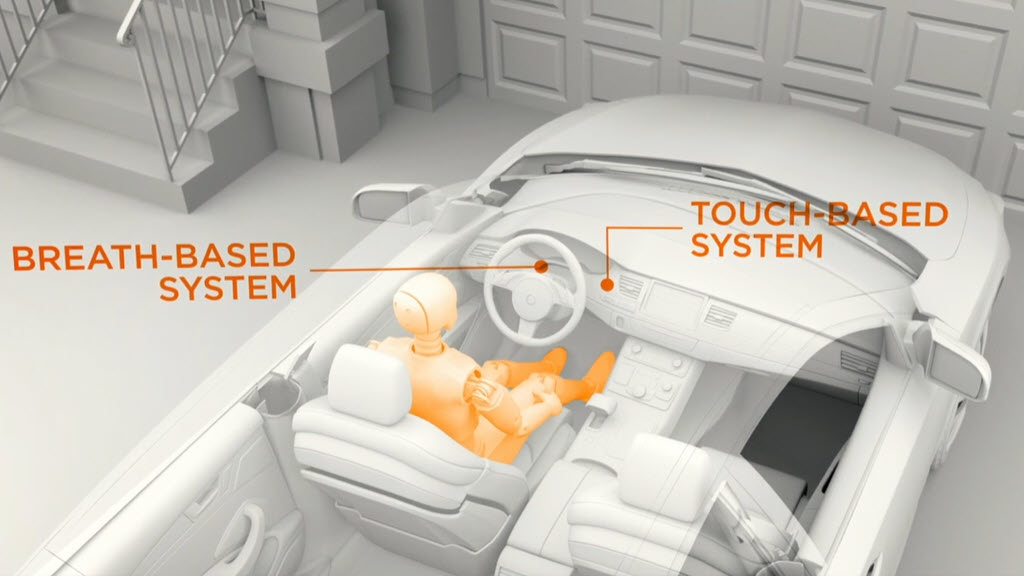
Drunk driving fatalities have been trending down for the last 40 years until the pandemic hit and lockdowns began in 2020. Since then, drunken driving fatalities have spiked by 9% in 2020 compared to 2019. What’s more astounding is that spike comes even as vehicle miles traveled decreased by more than 430 billion miles according to a recently released report by the National Highway Traffic Safety Administration (NHTSA).

It’s likely that spike was just enough to push the House and the Senate to pass new legislation included in the $1.2 trillion infrastructure bill that President Biden recently signed into law on November 15, 2021.
“The distilled spirits industry, traffic safety advocates, and communities across America applaud President Biden for his Administration’s leadership and commitment to putting an end to impaired driving,” said President & CEO, Distilled Spirits Council of the United States – DISCUS and Responsibility.org Chris Swonger.
“The law provides important new resources, long-sought among traffic safety advocates, to prevent impaired driving by installing innovative advanced prevention technology in new vehicles.
“States will also be better positioned to address impaired driving in all forms, including multiple-substance impaired driving—an emerging threat on our nation’s roads. Combining substances leads to a dangerous effect on driver impairment and can dramatically increase the risk of crashing.”
Facts Shared by Mothers Against Drunk Driving (MADD)

- Arrest data from the FBI reveals that an average drunk driver has driven drunk more than 80 times before a first arrest.
- About one-third of all drivers arrested or convicted of drunk driving are repeat offenders.
- Impaired driving exacts $44 billion in economic costs and $210 billion in comprehensive costs to society
It’s Time to Use Technology to End Drunk Driving
Stay Informed: Sign up here for the Distillery Trail free email newsletter and be the first to get all the latest news, trends, job listings and events in your inbox.
The group best known in the U.S. to fight for drunk driving prevention is Mothers Against Drunk Driving (MADD). Since MADD’s founding 40 years ago, their 3E’s strategy to put an end to drunk driving uses the following approach.
- Education
- Enforcement
- Engineering
MADDs efforts have helped to reduce drunk driving deaths by 52 percent—from approximately 21,100 a year down to about 10,100 annually. Up until the pandemic, drunk driving deaths had hit a plateau in recent years. MADD feels that the next step to eliminate drunk driving is prevention technology.
The new H.R.3684 – Infrastructure Investment and Jobs Act law states that, “Alcohol-impaired driving fatalities represent approximately one-third of all highway fatalities in the United States each year. In 2019, there were 10,142 alcohol-impaired driving fatalities in the United States involving drivers with a blood alcohol concentration level of .08 or higher, and 68% of the crashes that resulted in those fatalities involved a driver with a blood alcohol concentration level of .15 or higher.
“To ensure the prevention of alcohol-impaired driving fatalities, advanced drunk and impaired driving prevention technology must be standard equipment in all new passenger motor vehicles.”
According to reporting from the Insurance Institute for Highway Safety, “Advanced drunk and impaired driving prevention technology can prevent more than 9,400 alcohol-impaired driving fatalities annually.”
The full text of “H.R.3684 – Infrastructure Investment and Jobs Act” that pertains to drunk driving prevention is included below.
What is “Advanced Drunk and Impaired Driving Prevention Technology” Will Be Required?
The new law sets a timeline to define what the technology solution will be without defining what the technology is at this point. It does provide a guideline of three options that have been developed over the last several years.
A federally mandated safety standard is needed to move this lifesaving technology from the research and development stage into an installation requirement for all new automobiles. The good news is the technology that could eliminate drunk driving already exists.
Here is a good summary of three technology options provided by MADD.
- Driving performance monitoring systems that monitor the vehicle movement with systems like lane departure warning and attention assist;
- Driver monitoring systems that monitor the driver’s head and eyes, typically using a camera or other sensors;
- Alcohol detection systems that use sensors to determine whether a driver is drunk and then prevent the vehicle from moving.
MADD added that it is neutral about the specific technology that should be deployed.
H.R.3684 identifies two main technology solution options or a combination of the two.
(A) The technology can passively monitor the performance of a driver of a motor vehicle to accurately identify whether that driver may be impaired; and prevent or limit motor vehicle operation if an impairment is detected. (B) The technology can passively and accurately detect whether the blood alcohol concentration of a driver of a motor vehicle is equal to or greater than the blood alcohol concentration described in section 163(a) of title 23, United States Code; and prevent or limit motor vehicle operation if a blood alcohol concentration above the legal limit is detected. (C) Or a combination of systems described in (A) and (B).
What is the Timing for Defining and Implementing the Anti-Drunk Driving Technology?
The timing for the Advanced Drunk and Impaired Driving Prevention Technology Safety Standard must be defined not later than three years after the date of enactment of this Act. At that time, it will be up to the Secretary of Transportation to issue a final rule prescribing a federal motor vehicle safety standard.
Once defined, the ruling will require passenger motor vehicles manufactured after the effective date of that standard to be equipped with advanced drunk and impaired driving prevention technology starting two years and not more than three years to begin compliance.
With this timeline in mind, the earliest we could see this new technology required in new cars will be 2026.
“While there is still much work to be done,” added Swonger. “The signing of this life-saving law takes a big step forward in eliminating impaired driving—once and for all.”
What Will the New Drunk Driving Prevention Technology Cost?
We reached out to Responsibility.org to try to get some insights on what the new technology will cost for new cars or fleet vehicles in the future. The short answer is no one knows yet. Brandy Axdahl, Senior Vice President, Responsibility Initiatives provided us with a lot more detail on this important and very complex issue.

“No one knows re: costs yet, but we have always insisted, and everyone has agreed, that any technology developed must be reliable, accurate, unobtrusive to the sober driver, and available at a reasonable cost,” said Axdahl.
“The new law moves this process forward with a rulemaking process at NHTSA. It will provide a more transparent process along the way, which is important. There are hundreds of issues that must be examined and acted upon as the technology is tested for feasibility. Another key action NHTSA needs to undertake with the automakers is public acceptance of this technology.
“I often refer to this as a moonshot to end impaired driving. It holds tremendous promise. We believe it will happen, but it if it’s not possible to develop within the five-year timeframe, the law specifically allows DOT to request more time to implement the rulemaking. NHTSA and automakers have learned important lessons (airbags that killed small people in the front seats are one example, the short-lived shoulder safety belt that fastened itself is another) of what happens when a rulemaking process is rushed.
“The effort to develop advanced technology to prevent drunk driving has been underway for 15+ years at NHTSA and has been funded at an 80/20 split (NHTSA/Automakers). That project, the Driver Alcohol Detection System for Safety (DADSS), would measure a person’s BAC via sweat or passive breath or both and would not allow a car to start if the BAC is at or above a .08 BAC level. That effort has plodded along and won’t be ready until at least 2024/2025.
“Different technology already exists that employs a combination of sensors and camera technology to discern if a driver has eyes on the road and is driving safely. This is technology is similar to the advanced safety features on newer cars already and is “impairment blind” meaning it watches for dangerous driving, regardless of whether or not it is alcohol/drug/distraction/fatigue-related or a medical emergency.
“All of the potential technologies will be moved forward via the rulemaking process. Although the rulemaking effort is slated for five years in the new law, most people seem to think it will likely take 10 years. Then it will take another 10 years (minimum) for fleet turnover when everyone has this technology in their vehicles. So, while this holds tremendous promise to end impaired driving, it is important to keep up all of our efforts in the meantime.
“Much remains to be seen including – will autonomous vehicles develop more quickly than this technology and if so, will autonomous vehicles incorporate this technology?”
Here’s One Auto Maker’s Take on Intervention Against Intoxication or Distracted Driving Solutions
Here is one car manufacturers insights into how they are looking for a solution against intoxicated or distracted driving.
H.R.3684 – Infrastructure Investment and Jobs Act
SEC. 24220. ADVANCED IMPAIRED DRIVING TECHNOLOGY.
(a) Findings.--Congress finds that--
(1) alcohol-impaired driving fatalities represent approximately
\1/3\ of all highway fatalities in the United States each year;
(2) in 2019, there were 10,142 alcohol-impaired driving
fatalities in the United States involving drivers with a blood
alcohol concentration level of .08 or higher, and 68 percent of the
crashes that resulted in those fatalities involved a driver with a
blood alcohol concentration level of .15 or higher;
(3) the estimated economic cost for alcohol-impaired driving in
2010 was $44,000,000,000;
(4) according to the Insurance Institute for Highway Safety,
advanced drunk and impaired driving prevention technology can
prevent more than 9,400 alcohol-impaired driving fatalities
annually; and
(5) to ensure the prevention of alcohol-impaired driving
fatalities, advanced drunk and impaired driving prevention
technology must be standard equipment in all new passenger motor
vehicles.
(b) Definitions.--In this section:
(1) Advanced drunk and impaired driving prevention
technology.--The term ``advanced drunk and impaired driving
prevention technology'' means a system that--
(A) can--
(i) passively monitor the performance of a driver of a
motor vehicle to accurately identify whether that driver
may be impaired; and
(ii) prevent or limit motor vehicle operation if an
impairment is detected;
(B) can--
(i) passively and accurately detect whether the blood
alcohol concentration of a driver of a motor vehicle is
equal to or greater than the blood alcohol concentration
described in section 163(a) of title 23, United States
Code; and
(ii) prevent or limit motor vehicle operation if a
blood alcohol concentration above the legal limit is
detected; or
(C) is a combination of systems described in subparagraphs
(A) and (B).
(2) New.--The term ``new'', with respect to a passenger motor
vehicle, means that the passenger motor vehicle--
(A) is a new vehicle (as defined in section 37.3 of title
49, Code of Federal Regulations (or a successor regulation));
and
(B) has not been purchased for purposes other than resale.
(3) Passenger motor vehicle.--The term ``passenger motor
vehicle'' has the meaning given the term in section 32101 of title
49, United States Code.
(4) Secretary.--The term ``Secretary'' means the Secretary of
Transportation, acting through the Administrator of the National
Highway Traffic Safety Administration.
(c) Advanced Drunk and Impaired Driving Prevention Technology
Safety Standard.--Subject to subsection (e) and not later than 3 years
after the date of enactment of this Act, the Secretary shall issue a
final rule prescribing a Federal motor vehicle safety standard under
section 30111 of title 49, United States Code, that requires passenger
motor vehicles manufactured after the effective date of that standard
to be equipped with advanced drunk and impaired driving prevention
technology.
(d) Requirement.--To allow sufficient time for manufacturer
compliance, the compliance date of the rule issued under subsection (c)
shall be not earlier than 2 years and not more than 3 years after the
date on which that rule is issued.
(e) Timing.--If the Secretary determines that the Federal motor
vehicle safety standard required under subsection (c) cannot meet the
requirements and considerations described in subsections (a) and (b) of
section 30111 of title 49, United States Code, by the applicable date,
the Secretary--
(1) may extend the time period to such date as the Secretary
determines to be necessary, but not later than the date that is 3
years after the date described in subsection (c);
(2) shall, not later than the date described in subsection (c)
and not less frequently than annually thereafter until the date on
which the rule under that subsection is issued, submit to the
Committee on Commerce, Science, and Transportation of the Senate
and the Committee on Energy and Commerce of the House of
Representatives a report describing, as of the date of submission
of the report--
(A) the reasons for not prescribing a Federal motor vehicle
safety standard under section 30111 of title 49, United States
Code, that requires advanced drunk and impaired driving
prevention technology in all new passenger motor vehicles;
(B) the deployment of advanced drunk and impaired driving
prevention technology in vehicles;
(C) any information relating to the ability of vehicle
manufacturers to include advanced drunk and impaired driving
prevention technology in new passenger motor vehicles; and
(D) an anticipated timeline for prescribing the Federal
motor vehicle safety standard described in subsection (c); and
(3) if the Federal motor vehicle safety standard required by
subsection (c) has not been finalized by the date that is 10 years
after the date of enactment of this Act, shall submit to the
Committee on Commerce, Science, and Transportation of the Senate
and the Committee on Energy and Commerce of the House of
Representative a report describing--
(A) the reasons why the Federal motor vehicle safety
standard has not been finalized;
(B) the barriers to finalizing the Federal motor vehicle
safety standard; and
(C) recommendations to Congress to facilitate the Federal
motor vehicle safety standard.
Please help to support Distillery Trail. Sign up for our Newsletter, like us on Facebook and follow us on Instagram and Twitter.





